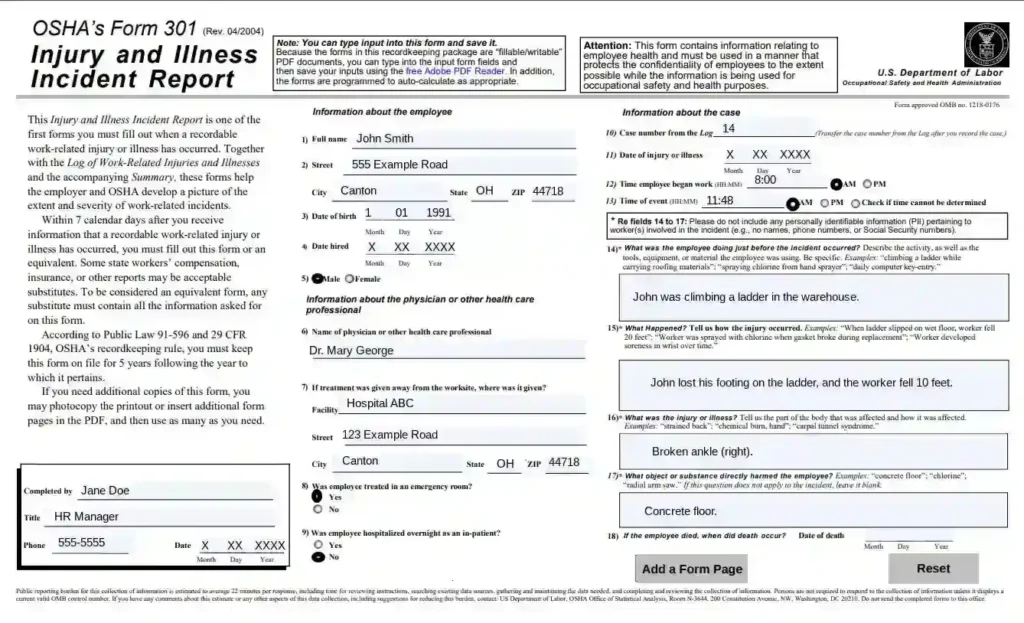Despite your best efforts, accidents can happen in the workplace. When they do, you must fill out a workplace incident report.
OSHA, the Occupational Safety and Health Administration, requires that all employers report qualifying workplace incidents. And, most employers must submit OSHA forms for other injuries and illnesses.
What are your requirements under the OSHA recordkeeping requirements?
Skip Ahead
OSHA overview
The Occupational Safety and Health Administration (OSHA) administers the Occupational Safety and Health Act of 1970 (OSH Act). The OSH Act is a federal law that sets and enforces occupational safety standards in the workplace. For example, OSHA regulates personal protective equipment in the workplace.
The OSH Act covers most private sector employers and employees in the United States, either by the Federal OSHA or by an OSHA-approved state job safety and health plan. OSHA-approved state plans may have more coverage than the OSH Act.
OSHA requires covered employers to:
- Display the OSHA Job Safety and Health: It’s the Law poster or the state equivalent
- Record work-related injuries and illnesses on the following OSHA forms:
- Form 300, Log of Work-Related Injuries and Illnesses
- Form 300A, Summary of Work-Related Injuries and Illnesses
- Form 301, Injuries and Illnesses Incident Report
- Make Form 300A available for employees, former employees, and their representatives to review, along with limited access to Form 301
- Report certain incidents to OSHA within the applicable timeframe
Employers with 10 or fewer employees don’t need to keep OSHA injury and illness records unless OSHA or the BLS says to. However, all employers covered by the OSH Act must report any workplace incident that results in fatality, amputation, the loss of an eye, or the in-patient hospitalization of one or more employees.
What is a workplace incident report?
A workplace incident report documents illnesses, injuries, and other health and safety incidents that take place in the workplace. The report provides a timely and detailed account of the event, including what happened and what caused it. The goal of a workplace employee incident report is to analyze the workplace event to prevent similar accidents in the future.
After an incident, fill out a report to:
- Comply with OSHA requirements: Employers covered by the OSH Act must report workplace incidents.
- Identify workplace hazards: A detailed account of a workplace incident can help you pinpoint patterns or recurring hazards.
- Prevent future incidents: Review the workplace incident report and make changes in your business to prevent similar occurrences.
- Improve workplace health and safety: Your business can learn from incidents to enhance safety protocols and training.
- Protect your business: You need a detailed account of the incident in case of lawsuits or workers’ compensation claims.
Keep a copy of all workplace incident reports in your records. OSHA requires that you keep the records for at least five years.
Consider preparing a workplace incident report even if you are not a covered employer under OSHA. Workplace incident reports can help keep your workplace safe and protect your business.
Who must report incidents to OSHA?
Employers with more than 10 employees must report recordable workplace incidents to OSHA.
Generally, employers with 10 or fewer employees during the previous calendar year do not need to complete OSHA forms for workplace incidents (unless OSHA or the BLS tells you to).
However, all employers must file a workplace employee incident report if the incident resulted in:
- Fatality
- In-patient hospitalization
- Amputation
- Loss of an eye
When should you file a workplace employee incident report?
Again, all employers must file a workplace incident report for events resulting in fatalities, in-patient hospitalization, amputation, or loss of an eye. Here are some other times you should file a report.
Create a report if an event or exposure caused or contributed to an employee’s workplace injury or illness or significantly aggravated a preexisting condition.
Record work-related injuries and illnesses that result in:
- Death
- Loss of consciousness
- Days away from work
- Restricted work activity or job transfer
- Medical treatment beyond first aid
Additionally, record the following work-related injuries or illnesses:
- Conditions diagnosed by a physician or other licensed healthcare professional
- Cancer
- Chronic irreversible disease
- Fractured or cracked bone
- Punctured eardrum
- Needlestick injury or cut that is contaminated with another person’s blood or other potentially infectious material
- Tuberculosis infection
- Confirmed tuberculosis infection
- Certain hearing test results
After receiving information about an event, you have seven days to decide if it’s recordable under OSHA recordkeeping requirements.
What to include in a workplace incident report
You can use OSHA’s Form 301, Injuries and Illnesses Incident Report, or an equivalent form. Acceptable substitutes, such as state workers’ compensation, insurance, or similar reports, must include the same information as Form 301.
OSHA’s Form 301 asks for the following:
- Information about the person completing the report (name, title, and phone number)
- Date of the report
- Information about the employee (name, address, date of birth, date hired)
- Information about the physician or other healthcare professional who treated the employee
- Whether the employee was treated in an emergency room
- Whether the employee was hospitalized overnight as an in-patient
- Information about the incident, including the date and time of the event
- Detailed descriptions about the event, including:
- What the employee was doing before the incident
- A detailed account of what happened
- What was the injury or illness
- What object or substance directly harmed the employee
- Whether the employee died and if so, when
| It takes employers an average of 22 minutes to complete OSHA Form 301. |
Example of workplace incident report
Take a look at the following screenshot of OSHA’s Form 301, Injury and Illness Incident Report, filled out to reflect an example incident:

Again, you must also use OSHA Form 300, Log of Work-Related Injuries and Illnesses, and Form 300A, Summary of Work-Related Injuries and Illnesses.
For more information on OSHA workplace incident forms, check out OSHA’s website. There, you can view PDF fillable forms and already-made spreadsheets.
How to report fatalities and other serious events
Federal OSHA rules state that all employers must report serious incidents, fatalities, in-patient hospitalization, amputation, or eye loss, by a certain timeframe.
Report incidents to OSHA by the following federal OSHA timeframes:
- Within 8 hours of finding out: Work-related fatalities that occur within 30 days of the work-related incident
- Within 24 hours of finding out: In-patient hospitalization, amputation, or eye loss occurring within 24 hours of the work-related incident
Report fatalities, in-patient hospitalization, amputation, or eye loss online or by phone. You can report by:
- Calling your nearest OSHA Area Office during normal business hours
- Calling the 24-hour OSHA hotline at 1-800-321-6742
- Completing the online report
Provide your business name, the names of the employees affected, the location and time of the incident, a brief description, and the contact person and phone number.
For more information, check out OSHA’s website.
This is not intended as legal advice; for more information, please click here.


